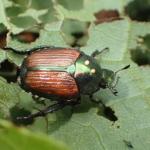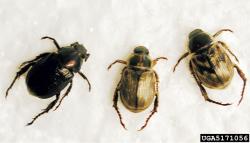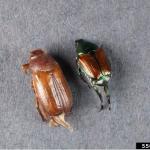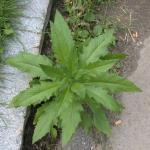A monthly e-newsletter from UMass Extension for landscapers, arborists, and other Green Industry professionals, including monthly tips for home gardeners.
To read individual sections of the message, click on the section headings below to expand the content.
To print this issue, either press CTRL/CMD + P or right click on the page and choose Print from the pop-up menu.
Featured Pathogen: Tobacco Rattle Virus (TRV)
Tobacco rattle virus (TRV) has a wide host range, affecting over 400 plant species in 50 families. Peony, bleeding heart, astilbe, hosta, epimedium, and coral bells are among the most common ornamental hosts. Many vegetable crops and weeds are also susceptible.
 Symptoms of TRV can vary according to host plant and environmental conditions. Mottling, mosaic, brown or yellow lesions, ringspots, streaks, and leaf deformities may occur. On peony, bleeding heart, and some other plants, the virus often produces striking yellow ring spots and patterns of wavy lines. Some plants may remain asymptomatic. In many cases, plants affected by TRV are not stunted and will flower normally.
Symptoms of TRV can vary according to host plant and environmental conditions. Mottling, mosaic, brown or yellow lesions, ringspots, streaks, and leaf deformities may occur. On peony, bleeding heart, and some other plants, the virus often produces striking yellow ring spots and patterns of wavy lines. Some plants may remain asymptomatic. In many cases, plants affected by TRV are not stunted and will flower normally.
TRV is transmitted by stubby root nematodes (Paratrichodorus and Trichodorus), microscopic roundworms that live in soil and feed on plant roots. The virus may also be spread mechanically on hands and tools, and by propagating infected mother plants.
There is no cure for infected plants. Remove infected plants and plant debris and dispose of everything in the trash. Disinfect tools frequently with 10% bleach or another antimicrobial solution. Use disease-free planting stock and inspect plants carefully for symptoms before bringing them into the garden or landscape. Avoid moving soil from the infested area into other areas. Although the virus is contagious, an infected plant may exist in the garden or landscape for many years without symptoms being observed in other plants. If the problem is consistent, consider replanting with plants that are not susceptible to TRV. These include zinnia, annual phlox, sweet William, and Datura species.
Angela Madeiras, UMass Extension Plant Pathologist
Trouble Maker of the Month
Introduced Scarab Beetles (Coleoptera: Scarabaeidae)
July to August is the season for scarab beetle damage. It is very common to notice leaf skeletonization (all tissue is eaten except the veins) and defoliation of some trees, shrubs, ornamentals, and garden plants. The most noticeable culprits are brightly colored, metallic beetles feeding in groups, namely Japanese beetles (Popillia japonica). Two other species, Oriental (Anomala orientalis) and Asiatic garden beetles (Maladera castanea) can cause similar damage, but because of their nocturnal activity they are less known and noticed.
All three of these species belong to the Scarabeidae family, also known as scarab beetles, and were introduced to the US (New Jersey and Connecticut) around the 1920s from Asia. They are also known as the most common and damaging introduced white grub species in Massachusetts. The adult feeding can weaken plants and reduce their aesthetic value, but rarely kills them. Their larvae are white grubs and cause their damage in August to September by feeding on plant roots, most commonly turfgrasses. Larval damage is not immediately noticed, but can be severe and lethal to turf if not managed.
In addition to the three species introduced from Asia, one more scarab beetle can cause problems in urban landscapes. European chafer (Amphimallon majale) was introduced from Europe in the 1940s. Even though adult beetles are not considered to be pests, their larvae can cause devastation in turfgrass.
Identification
Japanese beetles are probably one of the most known and recognizable species. Adults are 1/3 – 1/2” long, have coppery brown wings folded on the top of the body, and a metallic dark green head, thorax and underside (ventral) part of the body. The upper side of abdomen has alternating patches of black and white hairs (Figures 1 and 4 below). Oriental beetles are about the same size as Japanese beetles, but the coloration varies from straw-tan with darker patterns to dark brown/black (Figure 2). Asiatic garden beetle adults are also about the same size but are entirely brown without the iridescence (Figure 3). European chafer is the largest species (about ½” long) of the four and is reddish- or yellow- brown with visible yellow hairs.
Generalized life cycle
These damaging species have similar life cycles. There is only one generation per year. In 2023, Oriental and Asiatic garden beetle flight began in mid-June; the first Japanese beetles started flying in the third week of June, which is slightly earlier than previous years. The peak of Japanese beetle flight lasted two weeks, and currently the number of beetles has begun to decrease gradually. Oriental and Asiatic garden beetle flight peaked by the first week of July. We expect to see significantly fewer Japanese and Oriental beetle adults in August (based on observations from previous years) and adults will disappear completely by early September. Thus, the peak of damage caused by the adults is already over. Asiatic garden beetles stay active through August. Life cycle events of European chafer occur about 2 weeks earlier than Japanese beetle.
Currently (late July / early August), these beetles are laying eggs, and the first larvae have already been found in soil samples. Larvae, known as white grubs, are C-shaped, cream-colored, and have a reddish head and six legs (Figure 5). In August, larvae grow and molt into the second instar. As grubs grow, the damage becomes apparent. Third instars are observed in September. As the temperature drops, grubs dig deeper, stop feeding, and survive the winter in the soil. In the spring, grubs return to the surface to continue feeding, pupate, and emerge as adults in June to July.
Adult damage
Adults of Japanese, Oriental and Asiatic garden beetles cause feeding damage on foliage, flowers, and sometimes wounded or overripe fruits. The adults of these species are generalists and feed on a wide variety of plants. For instance, the adults of Japanese beetles feed on more than 300 species of trees, shrubs, perennials, and annual ornamental plants (they especially favor grapes, apple, cherries, roses, and strawberry). Oriental and Asiatic garden beetle adults feed on more than 100 plant species of trees (for example: boxelder, peach, cherry, and maple), shrubs (for example: viburnum, blueberry), and garden and ornamental plants (strawberry, carrot, beet, pepper, sunflower, corn, turnip). They are commonly found feeding on flowers of asters, petunias, phlox, dahlia, chrysanthemum, roses, goldenrod, butterfly bush, and Echinacea. Adults of all three species can be destructive; however, more often Japanese beetles are noticed because they are active and feed during the day, have very distinct coloration, and they feed in groups. Oriental beetle can be seen feeding on flowers, but adult flight is at night (9:00 – 11:00 PM); therefore usually less noticed. Asiatic garden beetles are also active only at night (flight is at same time as Oriental beetles) and hide during the day in flower or other garden beds.
Adults of European chafers usually do not feed enough to be considered pests.
Larval damage
White grubs, or larvae of the scarab beetles, are commonly known as major turfgrass pests. They feed on roots, often severely weakening or even killing plants. Similar to the adults, the larvae have rather generalist feeding habits, even though most of their damage is caused affects turfgrasses. For instance, larvae of Oriental beetles often cause damage to nursery stock, strawberry plants, cranberries, and blueberries. It has recently been found to be a dominant white grub species in turf (60-95% of all grubs collected at a given location). Asiatic garden beetle larvae feed on a wide variety of plants and usually prefer weedy areas to short cut, well maintained turf. Asiatic garden beetle larvae are reported to feed deeper in the soil than other species, primarily on peripheral roots. Larvae of European chafer can be damaging to nursery stock and ornamental plants as well as turfgrasses.
Adult management
Adult beetles are hard to manage. Day-fliers, such as Japanese beetles, can be physically removed from the plant and dropped into soapy water. It is important to remove beetles before significant feeding occurs because plants release chemicals in response to feeding which attracts even more beetles to the area.
Physical barriers such as netting or caging plants during beetle flight are commonly used for small size fruit trees and shrubs. This method will also protect against night feeders, such as Oriental and Asiatic garden beetles. However, it cannot be used on plants in bloom which require pollination.
The mass trapping method is available for Japanese beetles only. The trap includes a lure composed of attractive plant volatiles and a sex pheromone of the Japanese beetle. The lure is very powerful, attracting both male and female beetles. The traps can be used in some settings as a mass trapping tool and as a monitoring tool, for instance to determine the beginning or peak of the flight to correctly time management strategies. However, the use of traps in urban landscape settings is not a guarantee for reduction of the population or preventing adult or larval feeding damage. Traps attract many more Japanese beetles than they catch. Often, due to overflow, beetles end up on nearby ornamental plants or turf. This can be solved by emptying the trap at least once a week or adjusting the receptacle size. Another issue is that many of the beetles flying in often land on nearby plants even when traps are not full. Research has demonstrated that traps must be placed at least 30 ft away from valuable plants that are susceptible to Japanese beetle feeding to avoid damage. This trap does not attract Oriental or Asiatic garden beetles (only occasional Oriental beetles were found in the traps during 3-years of monitoring).
Chemical applications provide only temporary solutions for adult control, are often not justified, require multiple applications, and can pose a risk to non-target organisms. The residual activity of biorational chemicals such as pyrethrin, neem oil, and Bacillus thuringiensis galleriae is less than a week (O. Kostromytska, unpublished data). Adult beetles feed extensively for at least one month, therefore multiple applications are needed to protect plants.
Insecticides such as carbamates or pyrethroids (bifenthrin, etc.) can provide protection for 1-2 weeks, depending on the weather, but they are broad-spectrum and harmful to other insects including natural enemies (predators and parasitoids) and pollinators. Neonicotinoids (imidacloprid, clothianidin, and others) can provide long term protection but they are harmful to pollinators and have recently became restricted use pesticides in Massachusetts. Chlorantraniliprole can provide up to 4 weeks of protection and has a low risk to bees. However, most of the long-lasting systemic chemicals can only be applied by professional applicators (see CAUTION statement below).
Larvae management
White grub management is common practice in turf systems. In areas with repeated infestations, a preventive application is often justified. Preventive applications are scheduled around the time when adults are laying eggs, approximately at the peak of adult flight. This application does not affect the adults or eggs; it targets the larvae hatching from the eggs. Systemic insecticides (neonicotinoids and anthranilic diamides) are used for this application and are taken up by the plant. Neonicotinoids (imidacloprid and clothianidin) are harmful to bees, whereas chlorantraniliprole (anthranilic diamide) has low risk to Hymenoptera pollinators.
If damage is noticed in August or September, soil samples will help determine if grubs are the problem. At this time, entomopathogenic nematodes can be used to manage larvae; specifically, Heterorhabditis bacteriophora is the best species for grub control. Broad-spectrum chemicals canalso be used curatively in late summer or fall; trichlorfon, carbaryl, and clothianidin can still be effective at this time.
Look out for natural enemies!
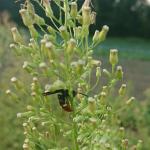 Introduced species usually have very few or no natural enemies in the new environments where they arrive, which is a reason for their species' success and severe outbreaks. Significant scientific efforts were put into researching and bringing the natural enemies of Japanese beetles into the US shortly after the arrival of the species.
Introduced species usually have very few or no natural enemies in the new environments where they arrive, which is a reason for their species' success and severe outbreaks. Significant scientific efforts were put into researching and bringing the natural enemies of Japanese beetles into the US shortly after the arrival of the species.
One of such natural enemies the winsome fly (Istocheta aldrichi). It was introduced to the US in 1920 as a classical biological control agent to combat the invasive Japanese beetle. The fly lays its eggs onto the pronotun of the beetles (Figure 1 above); female beetles are most likely to be parasitized. In about one day, the larvae hatch and burrow inside the beetle's body. Parasitized beetles dig into the soil and die within three days. The fly larvae feed and complete their development inside of the beetle's body.
Our lab has been monitoring Japanese beetle adult activity during the 2022 and 2023 seasons. On average, 14% (2,213 beetles) and 19% (2,291 beetles) of all collected beetles were parasitized by the winsome fly (Istocheta aldrichi, Figure 1 above) in 2022 and 2023 respectively. If you notice beetles with winsome fly eggs, release them. Parasitized beetles do not live longer than a couple of days and do not lay viable eggs, but this will allow the parasitoid to survive and continue its development. Winsome fly attacks Japanese beetles exclusively.
Several other grub parasitoids can attack different species of grubs. The spring Tiphia wasp (Tiphia vernalis) is another introduced parasitoid which attacks beetle larvae. Native Scoliid wasps are common grub parasitoids. Blue-winged wasp (Scolia dubia, Figure 6) is commonly seen in Massachusetts in August. The female wasp can detect grub feeding and, flying above the surface of an infested area in a figure-8 pattern, locate a grub and permanently paralyze it. It then lays its eggs on the grub. Wasp larvae consume the body of the white grub to complete their development.
CAUTION: All pesticides referenced above have been registered and approved for indicated uses according to the best available information at the time of publication. However, local, state, and federal laws and regulations pertaining to pesticides are subject to change. Pesticide applicators are advised to stay current with laws and regulations governing pesticides and their use. It is unlawful to use any pesticide in any manner other than the registered use. It is the responsibility of the applicator to verify the registration status of any pesticide for the intended use before applying it. Some pesticides referred to above may be classified “for restricted use only” in accordance with federal and/or state regulations. Persons using “restricted use” pesticides must be licensed and certified applicators. When using pesticides, users are further cautioned to read and strictly follow all directions on the pesticide label - the pesticide label is the law. In the event that pesticide label information is in conflict with information contained here, the label shall take precedence.
Olga Kostromytska, Stockbridge School of Agriculture, University of Massachusetts Amherst
Q&A
Q. I think I have identified pilewort on a property that I manage. Can you help me verify identification and tell me about its management?
A. Erechtites hieraciifolia, known as pilewort, fireweed, or American burnweed, has recently become a concern in more locations in New England.
Key characteristics:
- Family name: Asteraceae (Compositae) - Aster or Sunflower Family
- Life cycle: native annual, reproducing by seed
- Stems: erect, stout, branched, grooved or ribbed, smooth or sometimes sparsely haired
- Leaves: alternate, elliptic to oval, pinnately lobed, sharply and irregularly toothed, petioled or sessile. KEY VEGETATIVE CHARACTERISTIC: LEAF MARGINS ARE DOUBLE SERRATED!!
- Flowers: heads of white to sometimes cream-colored disk (tubulate) florets, florets extend only a short distance above bracts; terminal panicles, forms 'puffballs' when mature
- The species is a prolific seeder and seeds at maturity have a pappus (the little parachute-like structure on a dandelion seed) that aids in dissemination. Fortunately, pilewort is a summer annual and can be effectively hand weeded when plants are small. Since it is a prolific seeder, plants should be prevented from going to seed.
Q. I heard that RodeoTM is no longer registered for use in Massachusetts. Is this true?
A. For a short period of time this past spring, RodeoTM was not registered in Massachusetts. However, RodeoTM (EPA Reg# 62719-324) has been re-registered for use in MA.
Q. In a landscape bed on a property that I manage, there are many seedlings below a group planting of rose-of-Sharon. Could these be seedlings be rose-of-Sharon seedlings?
A. Yes, most definitely, since rose-of-Sharon is a prolific seeder. See the Landscape Message for July 28 (issue 14) under the Landscape Weeds header for management details.
Randy Prostak, UMass Extension Weed Specialist
Garden Clippings Tips of the Month
August is the month to . . . .
-
Garden sensibly in the heat. Wear light-colored clothing, a wide-brimmed hat, sunblock, and insect protection. As much as possible, work during cooler early morning and evening hours. Drink plenty of water. Have a plan for a quick retreat to shelter should sudden thunderstorms crop up.
-
Sow vegetable crops for fall harvest. Lettuce, carrots, peas, beets, chard, spinach, turnips, and radishes are all candidates for late summer sowing. In areas of the vegetable garden that will remain vacant once spent crop plants are pulled, begin seeding a cover crop such as winter rye (at a rate of 2 to 4 ounces per hundred square feet of garden space) or oats (at a rate of 4 ounces per hundred square feet). Turn over the soil, scatter seed, and rake to cover the seed with soil. For more information on cover crops, see our UMass Extension Cover Crops fact sheet.
-
Pick and enjoy ripe tomatoes from the garden. However, in very hot weather (above 90 °F), tomatoes can get a bit mushy; pick them when they are pinkish in color and allow them to finish ripening indoors--away from direct sunlight. Pick and use split or blemished tomatoes right away. Later in the month, remove blossoms from tomato plants to encourage existing fruits to ripen.
-
Evaluate houseplants for repotting. Houseplants that have been summering outdoors may have outgrown their current containers. Repot any plants that need to be bumped up to larger containers several weeks prior to bringing them back indoors. When selecting a new container, choose one that is no more than 2 inches larger in diameter than the houseplant’s current pot.
-
Keep deadheading annuals and perennials to encourage more blooms and keep plants tidy. Revive sparsely blooming annuals by cutting them back about halfway and fertilizing. Do stop deadheading and fertilizing roses this month to slow their growth before cold weather arrives. With all the rain this summer, many plants have developed long, spindly stems that flop on the ground. Stake and hoop as needed to keep plants upright.
-
Dig, divide, and move daylilies after they have finished blooming. Choose an overcast day, preferably on the cool side, to do this work. A spade or sharp edger makes dividing large clumps easier. Replant smaller clumps at the same depth as original plants and be sure to water thoroughly immediately after planting, as well as periodically as needed through the fall.
-
Find jumping worms in the yard and garden. Jumping worms are invasive earthworms that live in the top layer of soil and thrash about when they are brought to the soil surface or are handled. They are particularly destructive to our native hardwood forests. To help curb the spread of jumping worms, refrain from moving soil or plants from infested yards. UMass Extension has several fact sheets with more information, including how to identify jumping worms and other frequently asked questions.
-
Continue watering newly planted trees and shrubs. Slow, deep watering a couple of times a week is preferable to a quick daily sprinkle. Use a soaker hose or leave a regular garden hose on a trickle to prevent runoff. Avoid pruning (except for removing dead, dying, and diseased branches) new or established trees and shrubs as fall approaches—pruning may stimulate new growth that may not harden in time for cold winter weather. Also, pruning wounds heal slowly on woody plants going into dormancy; this may result in dieback at the wound site.
-
Place bulb orders early to get the selection and quantity you desire. Sought-after tulip, allium, daffodil, and crocus varieties are often sold out by the time bulb planting weather arrives later in the fall. Online and mail order bulb companies frequently offer customer discounts and promotions to encourage early ordering.
-
Get out of a rut and make a change - in the lawn mowing pattern. Altering mowing patterns each time lawns are mowed helps prevent mower wheels from creating ruts in a lawn, particularly if the ground is soggy from rain. August is also a good time to sharpen mower blades; by this time of the year, blades will have become dull, resulting in grass being torn rather than cut. Torn grass blade tips are potential entry points for disease infections.
Jennifer Kujawski, Horticulturist
Permethrin: Not Your Parent's Bug Spray
For personal protection from tick bites, there seems to be a continuous series of communications on the best way to go about this…I just look at my daily Google Alerts. Repellents, aka “bug sprays”, are at the forefront of tactics in addition to daily tick checks. Generally, skin repellents like DEET are recommended and, unfortunately, all-natural botanical oil type formulations. I always point out a major difference here. A product like DEET or alternatives like picaridin are EPA registered products…test data are on file to support label claims on performance. The all-natural products are EPA registration exempt, meaning the manufacturer is not required to do testing, so these products are in the category of “buyer beware”.
Permethrin is usually mentioned in articles or Extension recommendations as a one sentence, tag-line option. I take this up a level to point out that this is the most effective tick bite prevention tactic in the toolbox. When I was initially doing research with this product in 2010, I found that if an adult stage deer tick was exposed to a permethrin treated surface for 60 seconds, it is guaranteed to die. So, I recommend treating pants, socks and footwear with permethrin. Treating footwear is key because, during the summer months, the stage of deer tick active is the nymph stage. These are the size of a poppy seed and are down in the leaf litter, and are basically responsible for 85% of all tick-borne disease in Massachusetts.
Treating clothing and footwear is easy. See capecod.gov/ticks, where Cape Cod Cooperative Extension has a ten part video series, including one on permethrin. Once you treat clothing, it will keep its tick killing activity through six washings. I recommend treating footwear every 4 weeks. Another option is to purchase factory-treated clothing. Activity on these items extends through 70 washings.
People, particularly parents, raise questions about exposure risk. EPA’s position can be found here. A summary of their fact sheet shows that exposure risk is quite low to toddlers up through pregnant women and nursing mothers. Part of this is due to the fact that chemicals like permethrin have very low dermal absorption and are metabolized fairly quickly. In Northeastern states, Lyme and other tick-borne diseases have a high rate of incidence, and children and older people are the most at risk. Since the risk of getting a tick-borne disease is essentially year-round, I strongly recommend wearing permethrin treated clothing/footwear when you are in tick habitat, which includes the edges of our yards.
Larry Dapsis, Cape Cod Extension Entomologist
Upcoming Events
For details and registration options for these upcoming events, go to the UMass Extension Landscape, Nursery, and Urban Forestry Program Upcoming Events Page.
- 8/17/23 - Weed Walk, Weston MA, 3:00 - 6:00 pm.
3 pesticide contact hours for categories 36, 37, 40, and Applicator's (Core) License; 1 MCLP, 1 MCA, 1 MCH, and 3 ISA credits available.
Pesticide Exam Preparation and Recertification Courses
These workshops are held virtually. Contact Natalia Clifton at nclifton@umass.edu or go to https://www.umass.edu/pested for more info.
Additional Resources
For detailed reports on growing conditions and pest activity – Check out the Landscape Message
For professional turf managers - Check out our Turf Management Updates
For commercial growers of greenhouse crops and flowers - Check out the New England Greenhouse Update website
For home gardeners and garden retailers - Check out our home lawn and garden resources
TickTalk webinars - To view recordings of past webinars in this series, go to: https://ag.umass.edu/landscape/education-events/ticktalk-with-tickreport-webinars
Diagnostic Services
Landscape and Turf Problem Diagnostics - The UMass Plant Diagnostic Lab is accepting plant disease, insect pest and invasive plant/weed samples. By mail is preferred, but clients who would like to hand-deliver samples may do so by leaving them in the bin marked "Diagnostic Lab Samples" near the back door of French Hall. The lab serves commercial landscape contractors, turf managers, arborists, nurseries and other green industry professionals. It provides woody plant and turf disease analysis, woody plant and turf insect identification, turfgrass identification, weed identification, and offers a report of pest management strategies that are research based, economically sound and environmentally appropriate for the situation. Accurate diagnosis for a turf or landscape problem can often eliminate or reduce the need for pesticide use. See our website for instructions on sample submission and for a sample submission form at http://ag.umass.edu/diagnostics.
Soil and Plant Nutrient Testing - The lab is accepting orders for Routine Soil Analysis (including optional Organic Matter, Soluble Salts, and Nitrate testing), Particle Size Analysis, Pre-Sidedress Nitrate (PSNT), Total Sorbed Metals, and Soilless Media (no other types of soil analyses available at this time). Testing services are available to all. The lab provides test results and recommendations that lead to the wise and economical use of soils and soil amendments. For updates and order forms, visit the UMass Soil and Plant Nutrient Testing Laboratory web site.
Tick Testing - The UMass Center for Agriculture, Food, and the Environment provides a list of potential tick identification and testing options at: https://ag.umass.edu/resources/tick-testing-resources.
